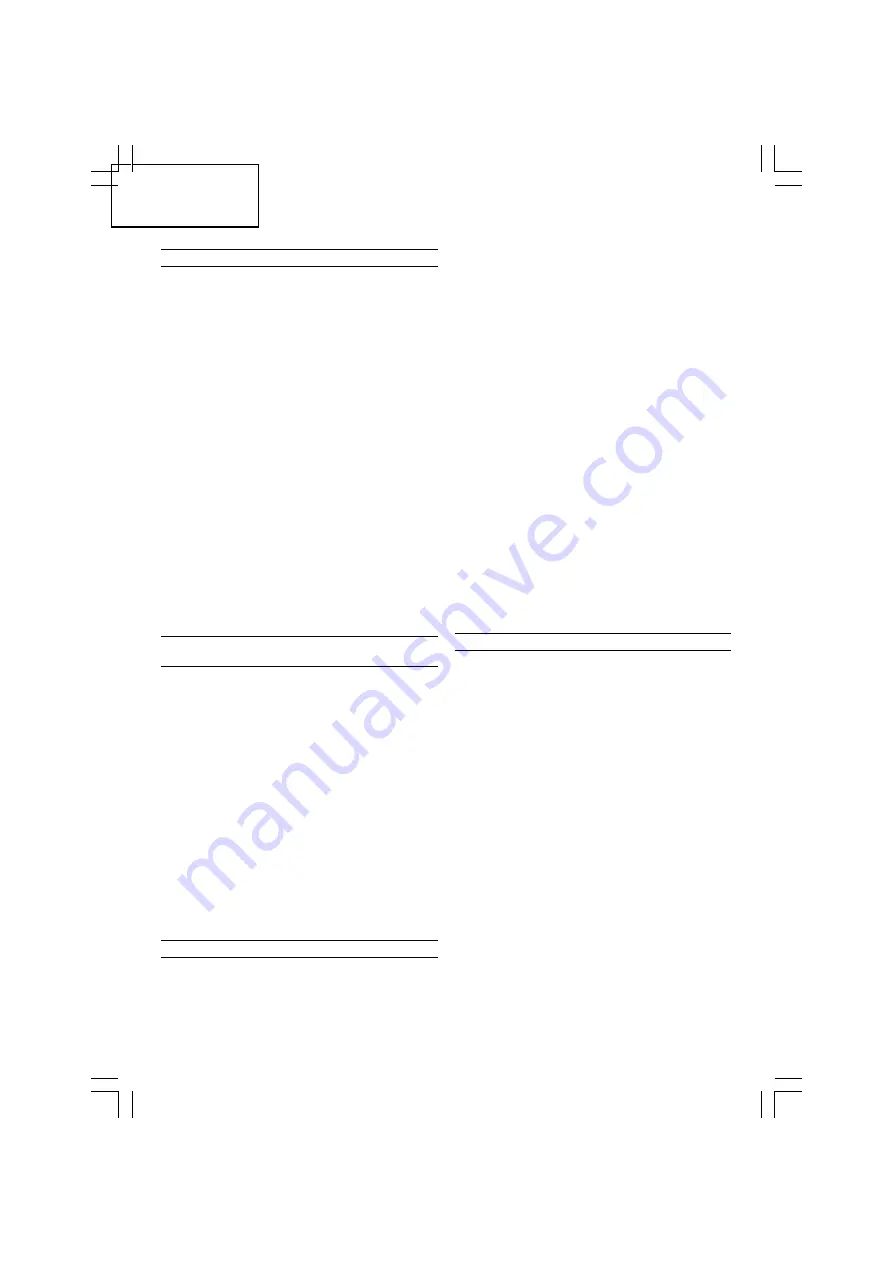
6
English
CUTTING PROCEDURES
CAUTION
It is dangerous to remove or install the workpiece
while the cut-off wheel turning.
1. Operating the switch
The switch is switched on by manually pulling the
trigger and cut off by releasing the trigger to the
original location. The switch can operate continuously,
even after releasing the trigger, by pushing the
stopper after pulling the trigger. The stopper can be
removed by pulling the trigger again and the switch
is cut off with the release of the trigger.
2. Cutting
(1) Rotate the cut-off wheel, gently press down the
handle, and bring the cut-off wheel close to the
cutting material.
(2) When the cut-off wheel contacts the cutting material,
gently press down the handle further and start cutting.
(3) When cutting (or designated slotting) is completed,
raise the handle and restore it to its original position.
(4) At the termination of each cutting process, turn OFF
the switch to stop rotation and proceed with the
subsequent cutting job.
CAUTION
It does not necessarily cut rapidly when putting
more force on the handle.
Too much force on the handle will put excessive
pressure on the motor and reduce its capacity.
Do not fail to switch OFF the switch after operation
is completed and pull the plug out.
MOUNTING AND DISMOUNTING THE CUT-
OFF WHEEL
CAUTION
Be sure to switch it OFF and have pulled the plug
from the power outlet to prevent any possible accident.
1. Dismounting the cut-off wheel (Fig. 2)
(1) Press the stopper and loosen the bolt with wrench.
CAUTION
When the mounting shaft for cut-off wheel cannot
be fixed with pressing the stopper, turn the bolt
with a wrench while pressing the stopper. The
mounting shaft for cut-off wheel is fixed when the
stopper has been lowered.
(2) Remove the bolt, washer (A), and the wheel washer
and detach the cut-off wheel.
2. Mounting the cut-off wheel
Throughly remove dust from the wheel washers
and bolt then mount the wheel by following the
dismounting procedures in reverse order.
CAUTION
Confirm that the stopper which was used for
installation and removal of the cut-off wheel has
returned to the retract position.
HOW TO OPERATE
Be sure to switch it OFF and have pulled the plug from
the power outlet to prevent any possible accident.
1. Procedure for fixing the cutting material (Fig. 8
and 9)
Place the workpiece material between vise (A) and
vise (B), raise the clutch and push the screw handle
to bring vise (A) lightly into contact with the
workpiece material, as shown in
Fig. 8
.
Then, turn the clutch down, and securely fix the
workpiece material in position by turning the screw
handle. When the cutting job is completed, turn the
screw handle 2 or 3 times to loosen the vise, and
remove the workpiece material, as shown in
Fig. 9
.
CAUTION
Never remove or install a workpiece material while
the cut-off wheel is rotating, to avoid personal injury.
2. Cutting at angles (Fig. 3 and 4)
(1) The machine permits cutting at angles of 45° or 60°.
(2) Loosen the two M10 bolts on the vise-jaw (B), then
set the working surface on the vise-jaw at any angles
of 0°, 30°, or 45° as shown in
Fig. 4
. Upon completion
of setting, securely tighten the two M10 bolts.
3. Moving the stationary vise-jaw (Fig. 6)
The vise opening is set at the maximum of 160 mm
when shipped from the factory. In case an opening
of more than 200 mm is required, move the vise-
jaw to the position shown by the chain line after
unscrewing the two bolts. The maximum opening
can be set in two steps 200 mm and 240 mm. When
the cutting material is excessively wide, the vise can
be effectively used by repositioning the stationary
side of the vise-jaws.
4. How to use metallic block (Fig. 7)
When the cut-off wheel has a reduced outer diameter,
insert between the vise-jaws (A) and (B) a metallic
block slightly smaller than the dimension of workpiece
being cut to use the cut-off wheel economically.
MAINTENANCE AND INSPECTION
CAUTION
Be sure to switch off and pull off the plug from
the power outlet before inspection and maintenance.
1. Replacing a cut-off wheel
When the cut-off wheel has already become dull
while continually using, the unnecessary load is got
from the motor. Consequently, redress or replace
a dull cut-off wheel to ensure grinding efficiency.
2. Inspecting the carbon brushes (Fig. 10)
The Motor employs carbon brushes which are
consumable parts. When they become worn to or
near the “wear limit”, it could result in motor trouble.
When an auto-stop carbon brush is equipped, the
motor will stop automatically. At that time, replace
both carbon brushes with new ones which have the
same carbon brush Number shown in the figure.
In addition, always keep carbon brushes clean and
ensure that they slide freely within the brush holders.
3. Replacing carbon brushes
Disassemble the brush cap with a screwdriver. The
carbon brush can then be easily removed.
4. Inspecting the mounting screws
Regularly inspect all mounting screws and ensure
that they are properly tightened. Should any of the
screws be loose, retighten them immediately. Failure
to do so could result in serious hazard.
5. Lubrication
Supply oil in the following oil supply points once
a month so as to keep the machine workable for
a long time (See
Fig. 1
).
(The machine oil is recommended.)
01Eng̲CC16SA̲ChT.p65
14.3.31, 1:04 PM
6
















